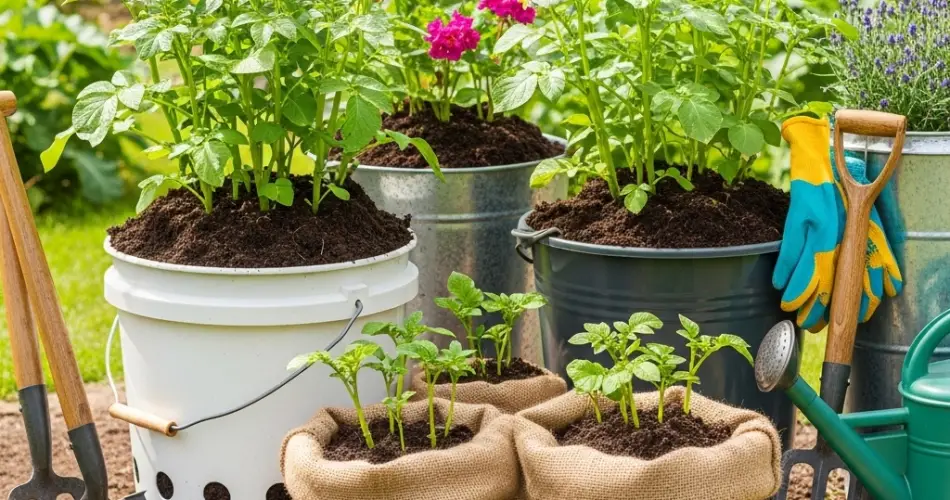Potatoes are a kitchen essential, and growing them at home is easier than many think. With just a little space and a few simple supplies, you can harvest abundant, fresh potatoes from containers right on your balcony, patio, or garden—all year round.
Whether you’re limited by space or want to avoid pests and soil diseases common in traditional gardening, growing potatoes in bags, buckets, or pots is an excellent solution. It’s clean, controlled, and perfect for beginners and seasoned gardeners alike.
In this article, you’ll learn step-by-step how to plant, grow, and harvest large quantities of potatoes in containers using simple techniques that maximize yield and minimize effort.
Why Grow Potatoes in Containers?
Container gardening offers several advantages:
-
Space efficiency: Ideal for balconies, patios, or small yards.
-
Pest control: Growing in bags or buckets reduces the risk of soil-borne diseases and pests like wireworms.
-
Mobility: Move your containers to follow the sun or protect them from weather extremes.
-
Extended growing season: You can start indoors or in sheltered areas and grow in succession throughout the year.
What You’ll Need
To get started, gather the following materials:
-
Seed potatoes (or sprouted potatoes from your kitchen)
-
Large containers: Buckets, grow bags, or sacks at least 30–40 cm deep
-
Quality soil: A mix of compost and well-draining potting soil
-
Mulch or straw (optional, for moisture control)
-
Fertilizer: Organic compost or slow-release balanced fertilizer
Step-by-Step Guide
1. Prepare the Seed Potatoes
If using large potatoes, cut them into chunks with at least one or two “eyes” (sprouts) per piece. Let the cut surfaces dry for 24–48 hours to prevent rotting.
If using small potatoes, you can plant them whole.
2. Prepare Your Container
Choose a pot or bag with drainage holes. Add 10–15 cm of potting mix to the bottom.
For better drainage and aeration, avoid using heavy garden soil alone. Mix compost, coconut coir, or perlite for best results.
3. Plant the Potatoes
Place the seed potatoes on the soil surface, eyes facing up. Space them 15–20 cm apart (for buckets, 2–3 potatoes is ideal).
Cover the potatoes with another 10 cm of soil.
4. Water and Wait
Water thoroughly after planting. Keep the soil evenly moist but not soggy. Potatoes like consistent moisture, especially during tuber formation.
Place your containers in a sunny spot—potatoes need at least 6–8 hours of sunlight daily.
The Secret to High Yields: Hilling Up
As the potato plants grow, they will produce stems and leaves. Once the stems are about 15–20 cm tall, add more soil or compost around the base of the plants—this is called “hilling.”
Repeat this process every time the plants grow taller, leaving the top leaves exposed. You can keep adding soil or mulch until the container is nearly full.
Hilling is crucial because potatoes form along the buried stems. The more you hill, the more potatoes you’ll harvest.
Maintenance and Care
-
Watering: Keep soil moist but not waterlogged. Check daily in hot weather.
-
Feeding: Add compost tea or organic fertilizer every 2–3 weeks to boost growth.
-
Pest watch: Look for signs of aphids or beetles. Remove pests manually or treat with natural remedies like neem oil.
-
Flowering: When plants start to flower, it’s a sign tubers are forming below.
When and How to Harvest
Small “new” potatoes can be harvested about 8–10 weeks after planting. For full-sized mature potatoes, wait until the plant’s foliage turns yellow and begins to die back—usually after 90–120 days.
To harvest:
-
Tip over the container or gently dig through the soil.
-
Collect the potatoes, brushing off excess soil.
-
Let them cure in a cool, dry, shaded place for a few days before storage.
Store potatoes in a dark, well-ventilated area. Avoid storing them in plastic bags or bright light, which can cause sprouting or greening.
Growing Tips for Year-Round Success
-
Succession planting: Start a new batch every month or two for continuous harvests.
-
Cold protection: In winter, move containers to a sheltered location or use row covers.
-
Choose the right variety: Early, mid, and late-season potato varieties offer flexibility for year-round production.
Final Thoughts
Growing potatoes in containers is an incredibly satisfying and productive gardening method. It doesn’t require a large garden or expensive tools—just a little patience, sunlight, and care. With proper planting and hilling techniques, you can harvest several kilos of potatoes from just a few buckets or bags.
Best of all, container-grown potatoes are clean, easy to access, and free of harmful chemicals. Whether you’re feeding a family or just want to grow your own food sustainably, container potato gardening is a smart and rewarding choice.
Give it a try and enjoy fresh, homegrown potatoes—any time of year.



